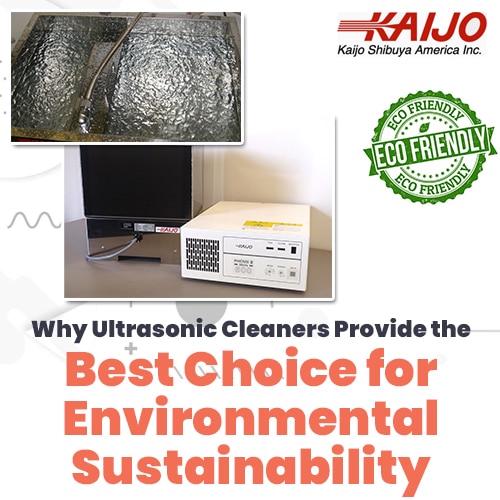Why Ultrasonic Cleaners Provide the Best Choice for Environmental Sustainability
July 20, 2023
 In addition to delivering excellent cleaning performance, ultrasonic cleaners represent an environmentally friendly cleaning solution. Industries are increasingly expected to reduce the environmental footprint of their operations and switch to environmentally sustainable processes. As regulations tighten and critical materials become scarce, traditional cleaning methods are becoming more costly. Such methods often use raw materials and local resources in an unsustainable manner. Ultrasonic cleaners are an environmentally sustainable solution that can reduce costs and deliver superior cleaning results.
In addition to delivering excellent cleaning performance, ultrasonic cleaners represent an environmentally friendly cleaning solution. Industries are increasingly expected to reduce the environmental footprint of their operations and switch to environmentally sustainable processes. As regulations tighten and critical materials become scarce, traditional cleaning methods are becoming more costly. Such methods often use raw materials and local resources in an unsustainable manner. Ultrasonic cleaners are an environmentally sustainable solution that can reduce costs and deliver superior cleaning results.
‘Sustainable’ Means Reducing Consumption and Waste to a Minimum
Achieving maximum environmental sustainability for an industrial process has four components:
- Reducing the consumption of materials to a minimum
- Increasing efficiency to minimize energy use
- Eliminating harmful outputs
- Complying with environmental regulations
Strategies that increase sustainability include recycling consumables and outputs, optimizing energy use, and eliminating process steps that are subject to regulation. Many industrial processes can be made more sustainable by modifying process steps, increasing process efficiency, or using a different process to achieve the same results. A sustainable business model will help preserve the environment while reducing operating costs.
Many Cleaning Methods Are Not Environmentally Sustainable
Most traditional cleaning methods fail to satisfy environmental sustainability requirements. Applications that include cleaning with aggressive chemicals, pressure washing, heated baths, and mechanical scrubbing are not environmentally friendly. Such methods feature a high consumption of chemicals and water, increased energy use for pumping and heating, and harmful toxic waste outputs even after neutralization.
These characteristics make it increasingly expensive to comply with environmental regulations. Any attempt to make traditional cleaning more sustainable reduces cleaning effectiveness. Reduced chemical usage or using less aggressive chemicals makes it easier to comply with regulations but results in longer cleaning times or incomplete cleaning. Increasing the cleaning intensity to improve output quality results in higher costs for chemicals, energy, and compliance. When improving output quality results in less environmental sustainability, it’s time to look for alternatives.
Ultrasonic Cleaning Is Highly Environmentally Sustainable
Ultrasonic cleaners consume no chemicals, are energy efficient, have no harmful outputs, and are mostly not subject to environmental regulations. The use of water and electricity is low compared to other cleaning methods. Ultrasonic cleaning works with plain water, although adding a mild detergent and heating the tank can speed up cleaning for some applications. The process is entirely safe, and the wastewater is usually not harmful to the environment.
Ultrasonic cleaning is a mechanical process in which microscopic cavitation bubbles are produced in the cleaning bath. The bubbles form and burst in tune with the ultrasonic frequency, typically ranging from between 20 kHz to 200 kHz. When the bubbles burst, they release a tiny, energetic jet of water that strikes the surface of the part to be cleaned and dislodges contaminants. The inputs are just water and possibly a small amount of detergent. The power used by Kaijo’s ultrasonic cleaning systems ranges from 600 to 1200 watts. The output is the water from the cleaning tank with the removed contaminants. The process is characterized by excellent environmental sustainability.
Switching to Ultrasonic Cleaning Provides Broad Benefits
Changing from using chemicals for cleaning to using ultrasonic cleaners benefits the environment, the business, and the local community. The production of the aggressive chemicals used for industrial cleaning applications involves mining and manufacturing that is not environmentally friendly. Delivery mishaps can also create significant problems. Reducing the demand for these chemicals will reduce these effects.
Switching to ultrasonic cleaning provides long-term cost benefits for industrial facilities. Increasingly expensive chemicals are no longer needed. The equipment for receiving, storing, using, and disposing of these chemicals can be removed. Additional savings result from lower regulatory compliance costs, no costs from mitigating chemical spills, and lower costs for employee safety equipment. Harmful effluent from the facility in the form of neutralized chemical waste is eliminated. Other secondary benefits include a safer workplace, better working conditions, and a positive reputation in the community can accrue as well.
Kaijo Helps Customers Transition to More Environmentally Sustainable Operations
As one of the leading ultrasonic cleaner manufacturers, Kaijo helps customers transition to having more environmentally sustainable business operations. Kaijo provides leading-edge ultrasonic cleaning technology to industrial facilities that reduce their environmental footprint and maximizes their environmental sustainability. Contact Kaijo for a free consultation to discuss your specific industrial cleaning process requirements.





